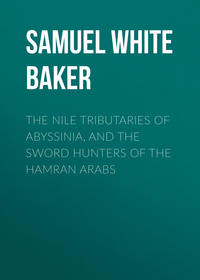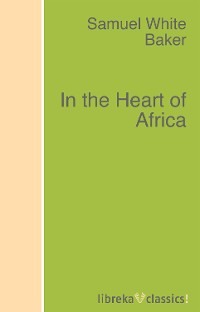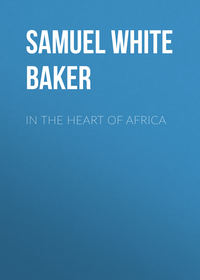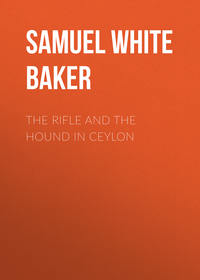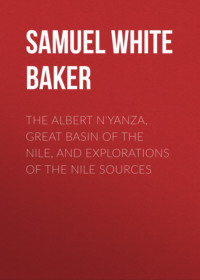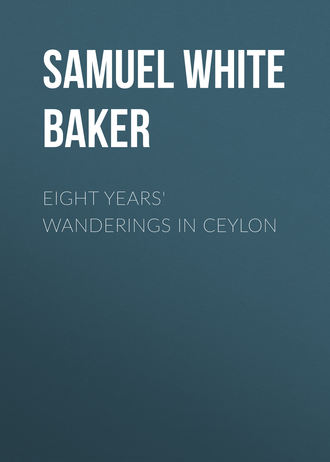 полная версия
полная версияEight Years' Wanderings in Ceylon
So fully aware are the natives of the impossibility of getting more than one crop out of the land that they plant all that they require at the same time. Thus may be seen in a field of korrakan (a small grain), Indian corn, millet and pumpkins, all growing together, and harvested as they respectively become ripe.
The principal articles of native cultivation are rice, korrakan, Indian corn, betel, areca-nuts, pumpkins, onions, garlic, gingelly-oil seed, tobacco, millet, red peppers, curry seed and sweet potatoes.
The staple articles of Ceylon production are coffee cinnamon and cocoa-nut oil, which are for the most part cultivated and manufactured by Europeans.
The chief article of native consumption, "rice," should be an export from Ceylon; but there has been an unaccountable neglect on the part of government regarding the production of this important grain, for the supply of which Ceylon is mainly dependent upon importation. In the hitherto overrated general resources of Ceylon, the cultivation of rice has scarcely been deemed worthy of notice; the all-absorbing subject of coffee cultivation has withdrawn the attention of the government from that particular article, for the production of which the resources of Ceylon are both naturally and artificially immense.
This neglect is the more extraordinary as the increase of coffee cultivation involves a proportionate increase in the consumption of rice, by the additional influx of coolie labor from the coast of India; therefore the price and supply of rice in Ceylon become questions of similar importance to the price of corn in England. This dependence upon a foreign soil for the supply involves the necessary fluctuations in price caused by uncertain arrivals and precarious harvests; and the importance of an unlimited supply at an even rate may be imagined when it is known that every native consumes a bushel of rice per month, when he can obtain it.
Nevertheless, the great capabilities of Ceylon for the cultivation of this all-important "staff of life" are entirely neglected by the government. The tanks which afforded a supply of water for millions in former ages now lie idle and out of repair; the pelican sails in solitude upon their waters, and the crocodile basks upon their shores; the thousands of acres which formerly produced rice for a dense population are now matted over by a thorny and impenetrable jungle. The wild buffalo, descendant from the ancient stock which tilled the ground of a great nation, now roams through a barren forest, which in olden times was a soil glistening with fertility. The ruins of the mighty cities tower high above the trees, sad monuments of desolation, where all was once flourishing, and where thousands dwelt within their walls.
All are passed away; and in the wreck of past ages we trace the great resources of the country, which produced sufficient food to support millions; while for the present comparatively small population Ceylon is dependent upon imports.
These lakes, or tanks, were works of much art and of immense labor for the purpose of reservoirs, from the supply of which the requisite amount of land could be irrigated for rice cultivation. A valley of the required extent being selected, the courses of neighboring or distant rivers were conducted into it, and the exit of the waters was prevented by great causeways, or dams, of solid masonry, which extended for some miles across the lower side of the valley thus converted into a lake. The exit of the water was then regulated by means of sluices, from which it was conducted by channels to the rice-lands.
These tanks are of various extent, and extremely numerous throughout Ceylon. The largest are those of Minneria, Kandellai, Padavellkiellom, and the Giant Tank. These are from fifteen to twenty-five miles in circumference; but in former times, when the sluices were in repair and the volume of water at its full height, they must have been much larger.
In those days the existence of a reservoir of water was a certain indication of a populous and flourishing neighborhood; and the chief cities of the country were accordingly situated in those places which were always certain of a supply. So careful were the inhabitants in husbanding those liquid resources upon which their very existence depended that even the surplus waters of one lake were not allowed to escape unheeded. Channels were cut, connecting a chain of tanks of slightly varying elevations, over an extent of sixty or seventy miles of apparently flat country, and the overflow of one tank was thus conducted in succession from lake to lake, until they all attained the desired level.
In this manner was the greater portion of Ceylon kept in the highest state of cultivation. From the north to the south the island was thickly peopled, and the only portions which then remained in the hands of nature were those which are now seen in the state of primeval forest.
Well may Ceylon in those times have deserved the name of the "Paradise of the East." The beauties which nature has showered upon the land were heightened by cultivation; the forest-capped mountains rose from a waving sea of green; the valleys teemed with wealth; no thorny jungles gave a barren terminable prospect, but the golden tints of ripening crops spread to the horizon. Temples stood upon the hill-tops; cities were studded over the land, their lofty dagobas and palaces reflected on the glassy surface of the lakes, from which their millions of inhabitants derived their food, their wealth and their very life.
The remains of these cities sufficiently attest the former amount of population and the comparative civilization which existed at that remote era among the progenitors of the present degraded race of barbarians. The ruins of "Anaradupoora," which cover two hundred and fifty-six square miles of ground, are all that remain of the noble city which stood within its walls in a square of sixteen miles. Some idea of the amount of population may be arrived at, when we consider the present density of inhabitants in all Indian houses and towns. Millions must, therefore, have streamed from the gates of a city to which our modern London was comparatively a village.
There is a degree of sameness in the ruins of all the ancient cities of Ceylon which renders a description tedious. Those of "Anaradupoora" are the largest in extent, and the buildings appear to have been more lofty, the great dagoba having exceeded four hundred feet in height; but the ruins do not exhibit the same "finish" in the style of architecture which is seen in the remains of other towns.
Among these, "Toparé," anciently called "Pollanarua," stands foremost. This city appears to have been laid out with a degree of taste which would have done credit to our modern towns.
Before its principal gate stretched a beautiful lake of about fifteen miles circumference (now only nine). The approach to this gate was by a broad road, upon the top of a stone causeway, of between two and three miles in length, which formed a massive dam to the waters of the lake which washed its base. To the right of this dam stretched many miles of cultivation; to the left, on the farther shores of the lake, lay park-like grass-lands, studded with forest trees, some of whose mighty descendants still exist in the noble "tamarind," rising above all others. Let us return in imagination to Pollanarua as it once stood. Having arrived upon the causeway in the approach to the city, the scene must have been beautiful in the extreme: the silvery lake, like a broad mirror, in the midst of a tropical park; the flowering trees shadowing its waters; the groves of tamarinds sheltering its many nooks and bays; the gorgeous blossoms of the pink lotus resting on its glassy surface; and the carpet-like glades of verdant pasturage, stretching far away upon the opposite shores, covered with countless elephants, tamed to complete obedience. Then on the right, below the massive granite steps which form the causeway, the water rushing from the sluice carries fertility among a thousand fields, and countless laborers and cattle till the ground: the sturdy buffaloes straining at the plough, the women, laden with golden sheaves of corn and baskets of fruit, crowding along the palm-shaded road winding toward the city, from whose gate a countless throng are passing and returning. Behold the mighty city! rising like a snow-white cloud from the broad margin of the waters. The groves of cocoa-nuts and palms of every kind, grouped in the inner gardens, throwing a cool shade upon the polished walls; the lofty palaces towering among the stately areca trees, and the gilded domes reflecting a blaze of light from the rays of a midday sun. Such let us suppose the exterior of Pollanarua.
The gates are entered, and a broad street, straight as an arrow, lies before us, shaded on either side by rows of palms. Here stand, on either hand, the dwellings of the principal inhabitants, bordering the wide space, which continues its straight and shady course for about four miles in length. In the centre, standing in a spacious circle, rises the great Dagoba, forming a grand coup d'oeil from the entrance gate. Two hundred and sixty feet from the base the Dagoba rears its lofty summit. Two circular terraces, each of some twenty feet in height, rising one upon the other, with a width of fifty feet, and a diameter at the base of about two hundred and fifty, from the step-like platform upon which the Dagoba stands. These are ascended by broad flights of steps, each terrace forming a circular promenade around the Dagoba; the whole having the appearance of white marble, being covered with polished stucco ornamented with figures in bas-relief. The Dagoba is a solid mass of brickwork in the shape of a dome, which rises from the upper terrace. The whole is covered with polished stucco, and surmounted by a gilded spire standing upon a square pedestal of stucco, highly ornamented with large figures, also in bas-relief; this pedestal is a cube of about thirty feet, supporting the tall gilded spire, which is surmounted by a golden umbrella.
Around the base of the Dagoba on the upper terrace are eight small entrances with highly-ornamented exteriors. These are the doors to eight similar chambers of about twelve feet square, in each of which is a small altar and carved golden idol. This Dagoba forms the main centre of the city, from which streets branch off in all directions, radiating from the circular space in which it stands.
The main street from the entrance-gate continues to the further extremity of the city, being crossed at right angles in the centre by a similar street, thus forming two great main streets through the city, terminating in four great gates or entrances to the town—north, south, east and west. Continuing along the main street from the great Dagoba for about a mile, we face another Dagoba of similar appearance, but of smaller dimensions, also standing in a spacious circle. Near this rises the king's palace, a noble building of great height, edged at the corner by narrow octagon towers.
At the further extremity of this main street, close to the opposite entrance-gate, is the rock temple, with the massive idols of Buddha flanking the entrance.
This, from the form and position of the existing ruins, we may conceive to have been the appearance of Pollanarua in its days of prosperity. But what remains of its grandeur? It has vanished like "a tale that is told;" it is passed away like a dream; the palaces are dust; the grassy sod has grown in mounds over the ruins of streets and fallen houses; nature has turfed them in one common grave with their inhabitants. The lofty palms have faded away and given place to forest trees, whose roots spring from the crumbled ruins; the bear and the leopard crouch in the porches of the temples; the owl roosts in the casements of the palaces; the jackal roams among the ruins in vain; there is not a bone left for him to gnaw of the multitudes which have passed away. There is their handwriting upon the temple wall, upon the granite slab which has mocked at Time; but there is no man to decipher it. There are the gigantic idols before whom millions have bowed; there is the same vacant stare upon their features of rock which gazed upon the multitudes of yore; but they no longer stare upon the pomp of the glorious city, but upon ruin, and rank weeds, and utter desolation. How many suns have risen and how many nights have darkened the earth since silence has reigned amidst the city, no man can tell. No mortal can say what fate befell those hosts of heathens, nor when they vanished from the earth. Day and night succeed each other, and the shade of the setting sun still falls from the great Dagoba; but it is the "valley of the shadow of death" upon which that shadow falls like a pall over the corpse of a nation.
The great Dagoba now remains a heap of mouldering brickwork, still retaining its form, but shorn of all its beauty. The stucco covering has almost all disappeared, leaving a patch here and there upon the most sheltered portions of the building. Scrubby brushwood and rank grass and lichens have for the most part covered its surface, giving it the appearance rather of a huge mound of earth than of an ancient building. A portion of the palace is also standing, and, although for the most part blocked up with ruins, there is still sufficient to denote its former importance. The bricks, or rather the tiles, of which all the buildings are composed, are of such an imperishable nature that they still adhere to each other in large masses in spots where portions of the buildings have fallen.
In one portion of the ruins there are a number of beautiful fluted columns, with carved capitals, still remaining in a perfect state. Among these are the ruins of a large flight of steps; near them, again, a stone-lined tank, which was evidently intended as a bath; and everything denotes the former comfort and arrangement of a first-class establishment. There are innumerable relics, all interesting and worthy of individual attention, throughout the ruins over a surface of many miles, but they are mostly overgrown with jungle or covered with rank grass. The apparent undulations of the ground in all directions are simply the remains of fallen streets and buildings overgrown in like manner with tangled vegetation.
The most interesting, as being the most perfect, specimen, is the small rock temple, which, being hewn out of the solid stone, is still in complete preservation. This is a small chamber in the face of an abrupt rock, which, doubtless, being partly a natural cavern, has been enlarged to the present size by the chisel; and the entrance, which may have been originally a small hole, has been shaped into an arched doorway. The interior is not more than perhaps twenty-five feet by eighteen, and is simply fitted up with an altar and the three figures of Buddha, in the positions in which he is usually represented—the sitting, the reclining and the standing postures.
The exterior of the temple is far more interesting. The narrow archway is flanked on either side by two inclined planes, hewn from the face of the rock, about eighteen feet high by twelve in width. These are completely covered with an inscription in the old Pali language, which has never been translated. Upon the left of one plain is a kind of sunken area hewn out of the rock, in which sits a colossal figure of Buddha, about twenty feet in height. On the right of the other plane is a figure in the standing posture about the same height; and still farther to the right, likewise hewn from the solid rock, is an immense figure in the recumbent posture, which is about fifty-six feet in length, or, as I measured it, not quite nineteen paces.
These figures are of a far superior class of sculpture to the idols usually seen in Ceylon, especially that in the reclining posture, in which the impression of the head upon the pillow is so well executed that the massive pillow of gneiss rock actually appears yielding to the weight of the head.
This temple is supposed to be coeval with the city, which was founded about three hundred years before Christ, and is supposed to have been in ruins for upward of six hundred years. The comparatively recent date of its destruction renders its obscurity the more mysterious, as there is no mention made of its annihilation in any of the Cingalese records, although the city is constantly mentioned during the time of its prosperity in the native history of Ceylon. It is my opinion that its destruction was caused by famine.
In those days the kings of Ceylon were perpetually at war with each other. The Queen of the South, from the great city of Mahagam in the Hambantotte district, made constant war with the kings of Pollanarua. They again made war with the Arabs and Malabars, who had invaded the northern districts of Ceylon; and as in modern warfare the great art consists in cutting off the enemy's supplies, so in those days the first and most decisive blow to be inflicted was the cutting off the "water." Thus, by simply turning the course of a river which supplied a principal tank, not only would that tank lose its supply, but the whole of the connected chain of lakes dependent upon the principal would in like manner be deprived of water.
This being the case, the first summer or dry season would lay waste the country. I have myself seen the lake of Minneria, which is twenty-two miles in circumference, evaporate to the small dimensions of four miles circuit during a dry season.
A population of some millions wholly dependent upon the supply of rice for their existence would be thrown into sudden starvation by the withdrawal of the water. Thus have the nations died out like a fire for lack of fuel. This cause will account for the decay of the great cities of Ceylon. The population gone, the wind and the rain would howl through the deserted dwellings, the white ants would devour the supporting beams, the elephants would rub their colossal forms against the already tottering houses, and decay would proceed with a rapidity unknown in a cooler clime. As the seed germinates in a few hours in a tropical country, so with equal haste the body of both vegetable and animal decays when life is extinct. A perpetual and hurrying change is visible in all things. A few showers, and the surface of the earth is teeming with verdure; a few days of drought, and the seeds already formed are falling to the earth, springing in their turn to life at the approach of moisture. The same rapidity of change is exhibited in their decay. The heaps of vegetable putridity upon the banks of rivers, when a swollen torrent has torn the luxuriant plants from the loosened soil, are but the effects of a few hours' change. The tree that arrives at maturity in a few years rots in as short a time when required for durability: thus it is no mystery, that either a house or a city should shortly fall to decay when the occupant is gone.
In like manner, and with still greater rapidity, is a change effected in the face of nature. As the flowers usurp the place of weeds under the care of man, so, when his hand is wanting, a few short weeks bury them beneath an overwhelming mass of thorns. In one year a jungle will conceal all signs of recent cultivation. Is it, therefore, a mystery that Ceylon is covered with such vast tracts of thorny jungle, now that her inhabitants are gone?
Throughout the world there is a perpetual war between man and nature, but in no country has the original curse of the earth been carried out to a fuller extent than in Ceylon: "thorns also and thistles shall it bring forth to thee." This is indeed exemplified when a few months neglect of once-cultivated land renders it almost impassable, and where man has vanished from the earth and thorny jungles have covered the once broad tracts of prosperous cultivation.
A few years will thus produce an almost total ruin throughout a deserted city. The air of desolation created by a solitude of six centuries can therefore be easily imagined. There exists, however, among the ruins of Pollanarua a curious instance of the power of the smallest apparent magnitude to destroy the works of man. At some remote period a bird has dropped the seed of the banian tree (ficus Indicus) upon the decaying summit of a dagoba. This, germinating has struck its root downward through the brickwork, and, by the gradual and insinuating progress of its growth, it has split the immense mass of building into two sections; the twisted roots now appearing through the clefts, while the victorious tree waves in exultation above the ruin: an emblem of the silent growth of "civilization" which will overturn the immense fabric of heathen superstition.
It is placed beyond a doubt that the rice-growing resources of Ceylon have been suffered to lie dormant since the disappearance of her ancient population; and to these neglected capabilities the attention of government should be directed.
An experiment might be commenced on a small scale by the repair of one tank—say Kandellai, which is only twenty-six miles from Trincomalee on the highroad to Kandy. This tank, when the dam and sluices were repaired, would rise to about nine feet above its present level, and would irrigate many thousand acres.
The grand desideratum in the improvement of Ceylon is the increase of the population; all of whom should, in some measure, be made to increase the revenue.
The government should therefore hazard this one experiment to induce the emigration of the industrious class of Chinese to the shores of Ceylon. Show them a never-failing supply of water and land of unlimited extent to be hid on easy terms, and the country would soon resume its original prosperity. A tax of five per cent. upon the produce of the land, to commence in the ratio of 0 per cent. for the first year, three per cent. for the second and third, and the full amount of five for the fourth, would be a fair and easy rent to the settler, and would not only repay the government for the cost of repairing the tank, but would in a few cars become a considerable source of revenue, in addition to the increased value of the land, now worthless, by a system of cultivation.
Should the first experiment succeed, the plan might be continued throughout Ceylon, and the soil of her own shores would produce a supply for the island consumption. The revenue would be derived direct from the land which now produces nothing but thorny jungle. The import trade of Ceylon would be increased in proportion to the influx of population, and the duties upon enlarged imports would again tend to swell the revenue of the country.
The felling and clearing of the jungle, which cultivation would render necessary, would tend, in a great measure, to dispel the fevers and malaria always produced by a want of free circulation of air. In a jungle-covered country like Ceylon, diseases of the most malignant character are harbored in these dense and undisturbed tracts, which year after year reap a pestilential harvest from the thinly-scattered population. Cholera, dysentery, fever and small-pox all appear in their turn and annually sweep whole villages away. I have frequently hailed with pleasure the distant tope of waving cocoa-nut trees after a long day's journey in a broiling sun, when I have cantered toward these shady warders of cultivation in hopes of a night's halt at a village. But the palms have sighed in the wind over tenantless abodes, and the mouldering dead have lain beneath their shade. Not a living soul remaining; all swept away by pestilence; huts recently fallen to decay, fruits ripening, on the trees, and no hand left to gather them; the shaddock and the lime falling to the earth to be preyed upon by the worm, like their former masters. All dead; not one left to tell the miserable tale.
The decay of the population is still progressing, and the next fifty years will see whole districts left uninhabited unless something can be done to prevent it. There is little doubt that if land and water could be obtained from government in a comparatively healthy and populous neighborhood, many would migrate to that point from the half-deserted districts, who might assist in the cultivation of the country instead of rotting in a closing jungle.
One season of pestilence, even in a large village, paves the road for a similar visitation in the succeeding year, for this reason:
Say that a village comprising two hundred men is reduced by sickness to a population of one hundred. The remaining one hundred cannot keep in cultivation the land formerly open; therefore, the jungle closes over the surface and rapidly encroaches upon the village. Thus the circulation of air is impeded and disease again halves the population. In each successive year the wretched inhabitants are thinned out, and disease becomes the more certain as the jungle continues to advance. At length the miserable few are no longer sufficient to cultivate the rice-lands; their numbers will not even suffice for driving their buffaloes. The jungle closes round the village; cholera finishes the scene by sweeping off the remnant; and groves of cocoa-nut trees, towering over the thorny jungle, become monuments sacred to the memory of an exterminated village.




